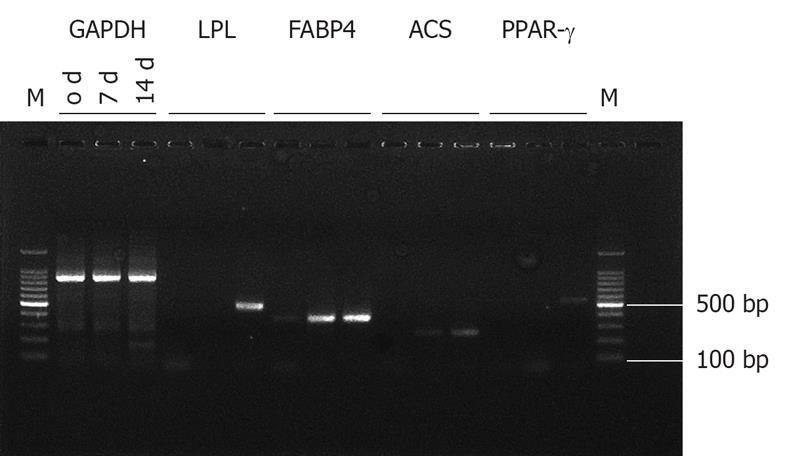Copyright
©2012 Baishideng.
World J Stem Cells. Apr 26, 2012; 4(4): 21-27
Published online Apr 26, 2012. doi: 10.4252/wjsc.v4.i4.21
Published online Apr 26, 2012. doi: 10.4252/wjsc.v4.i4.21
Figure 1 Human umbilical mesenchymal stem cells, adipogenic differentiation and red-o staining.
A is the human mesenchymal stem cells at passage 4, the cells assumed a more spindle-shaped, fibroblastic morphology; B-D demonstrate the human umbilical mesenchymal stem cells (HUMSCs) after 2 wk adipogenic differentiation without and with the Red-O staining, respectively. The differentiated cells’ shape had transformed into an ovoid/round morphology and there were abundant lipid droplets presented in the cell periphery; E is the HUMSCs with Red-O staining without differentiation, no lipid body is visible.
Figure 2 Reverse reverse transcriptase-polymerase chain reaction of the human umbilical mesenchymal stem cells and adipogenic differentiation.
After adipogenic differentiation induced for 1 and 2 wk, the mRNA expression of adipocyte-specific genes, such as peroxisome proliferator-activated receptor (PPAR)-γ, FABP4, acyl-CoA synthetase (ACS), and lipoprotein lipase (LPL) are visible more or less. This expression is absent in human umbilical mesenchymal stem cells, without differentiation.
Figure 3 Metabolic profile of human umbilical mesenchymal stem cells before and after adipogenic differentiation.
A and B are the nuclear magnetic resonance Spectrums of human umbilical mesenchymal stem cells (HUMSCs) and adipogenic differentiation, respectively. The two spectrums demonstrated that the levels of intracellular metabolites, such as choline, creatine, glutamate and acetate all decreased with the increased level of methionine, succinate and fatty acids after the HUMSCs differentiation 2 wk.
- Citation: Xu ZF, Pan AZ, Yong F, Shen CY, Chen YW, Wu RH. Human umbilical mesenchymal stem cell and its adipogenic differentiation: Profiling by nuclear magnetic resonance spectroscopy. World J Stem Cells 2012; 4(4): 21-27
- URL: https://www.wjgnet.com/1948-0210/full/v4/i4/21.htm
- DOI: https://dx.doi.org/10.4252/wjsc.v4.i4.21











